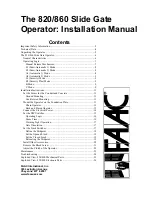
14
To mount the rack , slide the gate leaf open as far as it
will go. Then use the Manual Release lever to disengage
the operator's drive motor (turn the lever clockwise; see
Figure 2).
Lay a prepared section of rack on the pinion making
sure of the following:
•
The teeth of the rack are properly engaged.
•
The end of the rack is even with the end of the
gate leaf.
•
The rack is level.
Spot weld the spacer nearest the pinion to the gate leaf
(see Figure 9). Then pull the gate leaf toward the closed
position until the pinion is directly under the spacer on
the opposite end of the rack section and spot weld that
spacer.
After spot welding both end-of-rack spacers to the gate
leaf, you can spot weld the center spacer to the gate
leaf.
For the next rack section, place its end next to the end
of the previously installed section. Use an inverted
section of rack to properly align and space the next rack
section. Again be sure that the teeth of the rack are
properly engaged, that the two sections of rack are
aligned, and that the rack section is level.
Spot weld the new section of rack to the gate leaf,
welding the end closest to the previously welded section
first, the other end of the rack second, and the center
last. Spot weld all sections of rack in the same manner.
After spot welding the rack to the gate leaf, you need to
move the gate from the fully closed to the fully opened
position several times to make sure the rack moves
smoothly along the pinion. If it moves smoothly, finish
welding the spacers to the gate.
Finally, lower the operator about 1/16 in. (1.5 mm) and
again test the operation of the rack while the gate moves
from the fully opened to the fully closed position.
Connect the
Electrical Power
Note
: Be sure to ground the operator system
and protect the entire gate system with a main
power breaker switch. Refer to your local
electrical codes and ensure they are met when
you select these components.
The installer is responsible for providing a power cable
with ground protected by a circuit breaker from the
main 220 VAC power source to the operator.
All wiring should conform to applicable electrical codes
and all wiring and fittings should be weatherproof
and/or suitable for burial. Figure 10 shows a typical
gate
1. 746 Operator
2. Photocells
3. 3-button switch
4. Warning lamp
5. Switch
6. Main power circuit breaker
7. Junction box
1. 844 Operator
2. Photocells
3. 3-button switch
4. Warning lamp
5. Switch
6. Main power circuit breaker
7. Junction box
Figure 10. Typical gate system layout for an 820 or 860 Operator
Locate switches at
least 10 ft from the gate
820/ 860 Operator













































